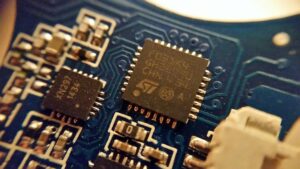Introduction to Accelerometers in Gaming
 Accelerometers have revolutionized the gaming industry by introducing enhanced motion control and immersive experiences. In this guide, we will explore the technology behind accelerometers, their applications in gaming, and the exciting future prospects they offer. With the integration of accelerometers, gaming has transcended traditional button inputs, allowing players to interact with the virtual world using their natural movements. This has opened up a whole new dimension of gameplay, where players can physically swing a sword, mimic sports actions, or even perform complex dance routines to control their in-game characters. The implementation of accelerometers has truly transformed gaming, making it more intuitive, interactive, and physically engaging.
Accelerometers have revolutionized the gaming industry by introducing enhanced motion control and immersive experiences. In this guide, we will explore the technology behind accelerometers, their applications in gaming, and the exciting future prospects they offer. With the integration of accelerometers, gaming has transcended traditional button inputs, allowing players to interact with the virtual world using their natural movements. This has opened up a whole new dimension of gameplay, where players can physically swing a sword, mimic sports actions, or even perform complex dance routines to control their in-game characters. The implementation of accelerometers has truly transformed gaming, making it more intuitive, interactive, and physically engaging.
What are Accelerometers?
Accelerometers are sensors that detect motion and changes in velocity. They measure acceleration forces in multiple directions, allowing devices to track movement accurately. In gaming, accelerometers are used to capture real-world movements and translate them into virtual actions, creating a more interactive and engaging gameplay experience. These sensors consist of tiny mechanical structures, typically based on Micro-Electromechanical Systems (MEMS) technology, which are capable of sensing even the slightest accelerations. By measuring these accelerations, accelerometers provide valuable input to gaming devices, enabling them to respond to a player’s physical gestures and movements in real-time.
The Technology behind Accelerometers
 Accelerometers in gaming as well as in other places like your phone, rely on Micro-Electromechanical Systems (MEMS) technology. MEMS accelerometers consist of tiny mechanical structures etched on a silicon chip. These structures respond to changes in acceleration, converting them into electrical signals that can be interpreted by gaming devices. MEMS accelerometers are known for their compact size, low power consumption, and high precision. The mechanical structures within the accelerometer are designed to vibrate or deflect in response to accelerations, generating electrical signals that are proportional to the applied forces. These signals are then processed and interpreted by gaming devices to accurately track the user’s movements and gestures.
Accelerometers in gaming as well as in other places like your phone, rely on Micro-Electromechanical Systems (MEMS) technology. MEMS accelerometers consist of tiny mechanical structures etched on a silicon chip. These structures respond to changes in acceleration, converting them into electrical signals that can be interpreted by gaming devices. MEMS accelerometers are known for their compact size, low power consumption, and high precision. The mechanical structures within the accelerometer are designed to vibrate or deflect in response to accelerations, generating electrical signals that are proportional to the applied forces. These signals are then processed and interpreted by gaming devices to accurately track the user’s movements and gestures.
Applications of Accelerometers in Gaming
A. Motion-Controlled Gameplay
Accelerometers enable motion-controlled gameplay, where players can use gestures and movements to control the game. By integrating accelerometers into controllers or wearable devices, games can respond to the user’s motions in real-time. This technology adds a new level of interactivity, allowing players to swing a virtual sword, steer a racing car, or perform precise movements with their characters. For example, in a motion-controlled sword-fighting game, players can physically swing their controller to execute sword attacks, making the gameplay more immersive and realistic. The precise tracking capabilities of accelerometers ensure that the in-game actions closely mimic the player’s real-world movements, creating a highly engaging and intuitive gaming experience.
Accelerometers also add a degree of accuracy to gaming that can help players hone their skills. For instance, in a sports game, players can practice their form and technique using motion-controlled gameplay. By using accelerometers, the game can provide feedback on how well they perform certain actions, allowing them to refine their movements and become better at the game. Furthermore, accelerometers can be used to provide targeted feedback on specific gaming maneuvers, such as shooting or passing a ball. With this level of detailed analysis, players can learn complex gaming strategies that are more difficult to master without the use of accelerometers.
 B. Virtual Reality (VR) Gaming
B. Virtual Reality (VR) Gaming
In virtual reality gaming, accelerometers play a crucial role in tracking head movements. VR headsets equipped with accelerometers can precisely detect when the player turns their head, allowing for a seamless exploration of virtual worlds. By accurately tracking the user’s motion, accelerometers enhance the sense of presence and immersion in the virtual environment.
For example, in a VR first-person shooter game, players can physically turn their head to look around the virtual battlefield, providing a more immersive and realistic experience. The accelerometers capture the subtle head movements and translate them into corresponding changes within the game, allowing players to feel fully immersed in the virtual world.
C. Augmented Reality (AR) Gaming
Accelerometers also contribute to augmented reality gaming on mobile devices. By combining accelerometers with other sensors like gyroscopes and magnetometers, AR games can accurately track the device’s orientation and movement in the real world. This enables the overlay of virtual elements onto the player’s surroundings, creating interactive and immersive AR experiences. For instance, in an AR treasure hunt game, players can use their mobile devices to navigate real-world locations, with the accelerometer tracking their movements and adjusting the position of virtual objects accordingly. This blending of virtual and real-world elements creates a unique gaming experience that seamlessly integrates digital content into the player’s environment.
Advancements and Future Prospects
Accelerometer technology is constantly evolving, driving advancements in the gaming industry. Future developments may include haptic feedback, where accelerometers provide physical sensations in response to virtual actions, further enhancing the gaming experience. For example, a player swinging a virtual tennis racket could feel the resistance and impact through vibrations generated by the accelerometer. Additionally, improved precision and sensitivity of accelerometers will enable more nuanced and realistic motion control.
This will allow for more accurate tracking of complex movements and gestures, facilitating the development of highly immersive and realistic gameplay. As the gaming industry continues to push boundaries, accelerometers are likely to play a central role in the development of innovative gaming experiences, blurring the lines between the virtual and real worlds.
Accelerometers have the potential to revolutionize the gaming landscape by providing users with unprecedented levels of control and responsiveness. For instance, they can be used to detect subtle differences in movement, allowing for the implementation of sophisticated motion-based controls. This could open up new possibilities in gaming, such as more realistic and immersive sports games or complex virtual reality experiences. Additionally, accelerometers could be used to recognize gestures and motions that will enable users to interact with virtual objects or environments in an intuitive manner. With the potential to revolutionize gaming experiences, accelerometers are poised to become a key player in the ever-evolving gaming industry.
Conclusion
Accelerometers have revolutionized gaming by introducing motion control and immersive experiences. From motion-controlled gameplay to virtual reality and augmented reality gaming, accelerometers enhance user interaction and create more engaging gameplay. The integration of accelerometers has allowed players to break free from the constraints of traditional button inputs, enabling them to use their natural movements and gestures to control their in-game actions.
With ongoing advancements in accelerometer technology, the future of gaming looks promising, offering even more realistic and immersive experiences for players worldwide. As technology continues to evolve, accelerometers will continue to play a pivotal role in shaping the future of gaming, providing new avenues for creativity and interaction within the virtual realm.








No Comment! Be the first one.